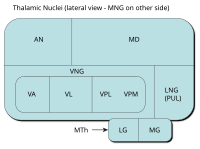
Photo from wikipedia
In the ascending auditory pathway, the central nucleus of the inferior colliculus (IC) receives and integrates excitatory and inhibitory inputs from many bilateral lower auditory nuclei, intrinsic projections within the… Click to show full abstract
In the ascending auditory pathway, the central nucleus of the inferior colliculus (IC) receives and integrates excitatory and inhibitory inputs from many bilateral lower auditory nuclei, intrinsic projections within the IC, contralateral IC through the commissure of the IC and from the auditory cortex. All these presynaptic excitatory and inhibitory inputs dynamically shape and modulate the auditory response properties of individual IC neurons. For this reason, acoustic response properties vary among individual IC neurons due to different activity pattern of presynaptic inputs. The present study examines modulation of auditory response properties of IC neurons by combining sound stimulation with focal electrical stimulation of the contralateral dorsal nucleus of the lateral lemniscus (referred to as ESDNLL) in the albino mouse. Brief ESDNLL produces variation (increase or decrease) in the number of impulses, response latency and discharge duration of modulated IC neurons. Additionally, 30-minute short-term ESDNLL alone produces variation in the best frequency (BF) and minimum threshold (MT) of modulated IC neurons. These varied response parameters recover in different manner and time course among individual modulated IC neurons. Possible pathways and neural mechanisms underlying these findings are discussed.
Journal Title: Neuroscience
Year Published: 2018
Link to full text (if available)
Share on Social Media: Sign Up to like & get
recommendations!